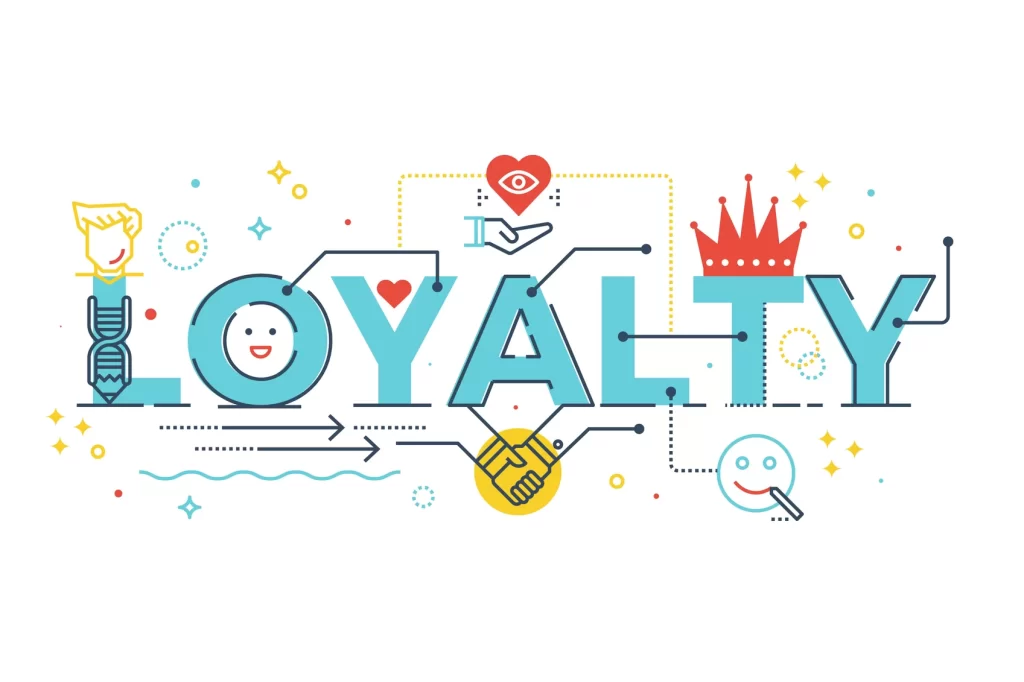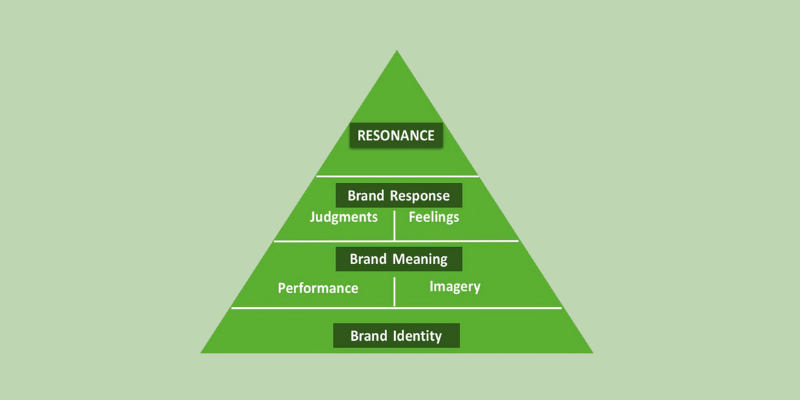Last Updated on 3 months by Gülenber Han
The brand of a firm is significant because it influences how customers perceive the quality of its products or services. That’s why brand consultancy services are very important. Brand equity, or the worth of a company’s brand, may be built in a variety of ways. If you’re a marketer, the Aaker Brand Equity Model may help you design a plan that will help your company’s brand equity grow, resulting in higher customer loyalty and happiness. In this article you will see brand equity and information about the Aaker Brand Equity Model, you will also learn about the components of brand equity and outline the parts of the model in the Aaker Brand Equity Model.
What is the Aaker model?
The Aaker Brand Equity Model is one of several ideas regarding how marketers might identify, assess, and improve a company’s brand. The notion was first suggested in the 1990s by David Aaker, a former lecturer at the University of California, Berkeley. Brand equity, according to this approach, is a mix of a brand’s recognition, loyalty, and perceived quality. These assets can assist a firm in increasing the value of its products or services, which can benefit the client in a variety of ways. Brand equity, according to the Aaker Brand Equity Model, can:
- Help customers learn, grasp, and retrieve more information about a brand: According to the concept, brand equity may assist customers in learning, understanding, and retrieving more information about a brand.
- Influence purchase decisions: According to the Aaker Brand Equity Model, buyers’ familiarity with a brand can boost their confidence in their purchasing decisions.
- Increase consumer happiness: According to the concept, brand equity helps people have faith in a brand’s quality, which may lead to increased customer contentment.
Elements of Brand Identity in the Aaker Model
The Aaker Brand Equity Model comprises various factors that may be used to define a company’s brand identity, which can aid in the development and maintenance of brand equity. In the Aaker Brand Equity Model, brand identity consists of the following elements:
Brand as a product
This aspect of brand identity is concerned with the product or service that a business offers to its clients. It contains the scope of the product, which is the collection of features that define it. It takes into account the product’s quality and client value. Customers who utilize a product and how they use it might also be included in this category.
Brand as an organization
The qualities of the organization are referred to by the brand as an organizational aspect. The location of a corporation and the reach of its products or services are examples of this aspect of brand identification. A small firm, for example, may have a strong local client base in its geographic region, but a major corporation may have a much larger audience. This section also looks at a company’s beliefs and culture, such as its goal statement.
Brand as a person
This aspect of brand identity focuses on a company’s relationships with its consumers. This factor, according to the Aaker Brand Equity Model, may also relate to a brand’s personality, which is similar to an individual’s personality. A company’s brand identity, for example, may be determined by a collection of descriptive features such as customer-oriented, trustworthy, and informal.
Brand as a symbol
The symbols associated with a brand are the final aspect of brand identification in the Aaker Brand Equity Model. A company’s logo, for example, may be considered part of its brand identity. Visual imagery, auditory sounds, or a brand’s history can all be used as symbol elements. According to the Aaker Brand Equity Model, these symbols can create a structure for a brand’s identity.
5 Components of Brand Equity in the Aaker Model
The Aaker Brand Equity Model offers five components that contribute to brand equity in addition to the factors of brand identity:
Brand loyalty

Customers’ support for a brand is measured by this component. A shopper who exclusively buys groceries at one supermarket, for example, has brand loyalty to that store. Strong brand loyalty, according to the Aaker Brand Equity Model, allows a firm to focus on sustaining its loyal clients, which may assist in saving marketing expenses. It also provides businesses an edge over their market competitors, who may struggle to persuade devoted customers to switch brands.
Why is brand loyalty important?
Building brand loyalty is a good marketing approach since it may boost sales without having to change some of the more expensive parts of manufacturing, such as product design or distribution. Here are a few reasons why brand loyalty is crucial:
- Consistent sales: Brand loyal customers buy from a firm again over time, resulting in steady revenue. They could also try other products from the same company, which might lead to more purchases. A brand-loyal client who buys the same brand of pasta every time might also want to sample the company’s spaghetti sauce.
- Brand equity: When customers can quickly recognize a brand and place a high value on it, this is known as brand equity. Your brand equity might serve as a reputation for your company and attract new consumers. Loyal customers are more inclined to promote items to their friends, therefore having a high degree of brand loyalty adds to that equity.
- Cost-effectiveness: Because of the high cost of marketing and consumer outreach, obtaining more one-time customers might be more costly than focusing on brand loyalty. You won’t have to devote as much time and effort to brand-loyal clients, lowering marketing expenditures and freeing up other resources. Instead, you may put your time and money into expanding your marketing reach, improving your services, or concentrating on other elements of your company.
Tips to increase brand loyalty
Here are some pointers on how to build consumer loyalty to your brand:
- Enhance customer service: For many clients, communicating with your customer service department is their sole contact with your company. Customers are more likely to return if they have had a great customer service contact, therefore it’s critical to treat them with an attitude that matches your company’s identity. You may engage with more customers and have more time for each of them by integrating customer relationship software, allowing you to demonstrate genuine care for their issues.
- Focus on your brand image: Your company’s brand image is one approach to ensure that it stands out. Because they are known, customers are more inclined to trust brands that are instantly recognized. You may create an identity that reflects your company’s values and those of your consumers. Customers may opt to stick with a brand that they think embodies their values, which may drive them to select your firm over your rivals regularly.
- Develop rewards programs: By giving incentives like discounts, promotions, or free items, you may create a rewards program that promotes repeat purchases. Customers may be more likely to return to a brand if they feel they will receive a discount or a promotion if they make repeated purchases. Customers are more likely to grow loyal to your brand if your promotions or discounts are appealing.
- Use social media: Social media is a great way to stay in touch with your consumers while also building your company identification. You may also utilize social media to communicate directly with your clients to develop an emotional connection with your business. Consider what type of material is most likely to interest your potential consumers, and aim to maintain a relationship with them through follow-ups, click-through rates, or direct involvement.
- Collaborate with brand ambassadors: A brand ambassador is someone who has a large following and may influence their purchasing decisions. You can collaborate with a brand ambassador whose personal brand aligns with your company’s. You can then get access to their network of influence, which can benefit the ambassador by allowing them to exert more influence on your customers.
- Monitor trends: Once your brand has acquired your clients’ devotion, you can focus on keeping your product and procedures up to date to sustain that loyalty. Continue to watch changes in your sector to avoid losing loyal consumers. You may continue to gain your consumers’ loyalty if you keep knowledgeable about their needs.
Brand awareness

The public’s familiarity with a brand is measured by brand awareness. For example, a corporation has high brand awareness if the majority of people in a certain region remember its name and are familiar with its products. According to the Aaker Brand Equity Model, firms with high brand recognition may exploit their community presence to attract more consumers, resulting in increased income. Customers may feel more confident in their decision to buy items or services from a firm if they are aware of this.
Why is brand awareness important?
In a world where customers rely on extensive research and the opinions of others before making a purchase, brand trust is paramount. Once a customer has formed a link with your brand, they are more likely to make repeat purchases with little to no consideration – bridging the trust and loyalty gap.
Brand awareness is the foundation for brand trust. Consumers are more likely to believe you if you give a face to your brand name. Brand awareness campaigns provide your company a face and a place to be genuine, collect feedback, and tell a narrative. These are all examples of how we as humans develop trust in one another. The human-brand relationship is no exception.
Brand equity refers to the value of a company defined by the overall perception of the brand and customer interactions with it. Pleasant brand equity comes from positive experiences and perceptions, and negative brand equity comes from negative perceptions.
Here are a few advantages of having positive brand equity:
- Prices are greater as a result of a higher perceived value.
- An increase in stock price
- The capacity to grow your firm by adding new products or services to your existing product or service line.
- Because of the brand name’s worth, it has a greater societal influence.
How to Build Brand Awareness
It takes time for your audience and the broader public to become aware of your brand. It also doesn’t happen as a result of a simple marketing effort or commercial.
Strong brand awareness is the outcome of several concurrent activities that go beyond attempting to acquire paying consumers.
You won’t go very far if you intend to create brand recognition by placing a few product adverts on Facebook. The buyer will not only be focused on the product (rather than the brand), but the advertisement will also have little influence beyond a simple transaction.
Here are some ideas for building a strong brand awareness foundation and making a lasting impression on your audience:
- Become a person, not a corporation: These are the characteristics that your brand should identify and promote. You must establish yourself as more than a firm that sells things if you want to make an impression on your audience. What other way would you describe yourself?
- Socialize: All humans benefit from social interaction and spending time with one another, whether they are introverts or extroverts. It’s how we remain in touch, learn new things, and become more well-known. The same may be said about your company’s brand. You won’t be known as anything other than a business with a single goal if you just try to engage with individuals when attempting to make a sale or acquire support. You must be social to build brand recognition. Post about topics unrelated to your product or service on social media.
- Tell a story: Whether you’re selling things or promoting your company, storytelling is a strong marketing tool. Because it provides your viewers with something tangible to grasp. Making a story out of your brand humanizes it and adds depth to it. Incorporating this narrative into your marketing promotes your brand as well as your products or services.
- Make it simple to share: Make it simple for your audience to share your material, regardless of your sector, product offering, or marketing techniques. Blog entries, sponsored content, videos, social media postings, and product sites are all examples of this. It makes no difference what it is as long as it can be shared.
Brand Awareness Strategy
You already know how to begin establishing your brand from the bottom up. It’s now time to set together a basic yet effective brand awareness plan to keep the flywheel spinning.
- Guest write on other specialty websites: Guest blogging is one of the most cost-effective strategies to raise brand exposure. You may use traffic that is already coming to another website to draw attention to your brand while also providing useful and relevant information. In other words, instead of pushing your product to people who aren’t ready to buy it, write down your brand voice and position yourself as a person first, then a company. Publishing sponsored content on specialized websites is another wonderful alternative to guest blogging.
- Co-marketing is a good option: Co-marketing is a great strategy to raise brand recognition since it not only allows you to tap into another company’s audience but also allows you to showcase who you are and what you have to offer in the marketplace. If your firm offers dog leashes and toys, for example, you may consider partnering with a dog walking app. The campaign itself might take a variety of forms: Create a joint offer or collaborate on an Instagram live. Collaborating with another company can help you double or even triple your reach.
- Advertise everywhere: Advertising may not promote brand awareness as much as it does product awareness, but it’s still one of the finest ways to get people to learn about your brand in a non-intrusive, low-touch fashion. Start with internet advertising, which includes paid social media and pay-per-click (PPC). You can establish programmatic advertising campaigns if you want to appear everywhere and execute more complex efforts on a large scale.
- Create a short, memorable slogan: Creating a brief motto or phrase is an easy technique to boost brand recognition and is a cornerstone of a great brand awareness strategy. It should clarify what makes you unique, what you have to offer, and why clients should select you.
How to Increase Brand Awareness
Your brand awareness has risen successfully and people are talking about you without even seeing an ad. Why not broaden your existing brand recognition and build on that solid foundation? What can you do as a company to increase and maintain brand awareness?
Here are a few marketing ideas to help you go beyond your initial approach and increase brand recognition.
- Provide a freemium service: Freemium is a business strategy in which a base product or product line is provided for free, with premium or enterprise-level items being charged for. Customers may have a taste of your brand and goods before purchasing if you provide a freemium alternative. It’s a try-before-you-buy chance that might endure indefinitely. It’s usual to provide a freemium option with the caveat that the brand’s watermark appears on any publicly visible aspects of the product or service. As a result, freemium is a win-win situation for both the customer and the brand: the user receives a free product, and the company receives a free promotion when people utilize it.
- Create free content: Content is a fun approach to building brand recognition since it’s the simplest way to display personality and offer thoughts and positions on problems — two key components that humanize and personify your business. The content doesn’t need to be written. You may also make films, infographics, podcasts, and other types of content. Written material, like blogs and downloadable manuals, is perhaps the most straightforward, but it’s far from the only choice.
- Sponsoring events is a certain method to get your brand in front of hundreds, thousands, or millions of individuals who are likely to fit into your target demographic. If you sponsor an event, your logo will appear on everything from banners to fliers to water bottles. Sponsoring an event also helps you to identify your brand with an event that matches your personality, hobbies, and passions, allowing customers to associate your brand with the aesthetic and character of that event. It can also aid in the development of brand awareness among highly specialized and qualified audiences.
- Create a personality for your brand: The first step in giving your brand a personality is to treat it like a person and define your story. The next step is to include this personality in your marketing campaigns. As your brand will emerge when you sell your products and services with personality, you cannot help but increase brand awareness. Sure, your customers will notice the jeans or spaghetti you’re selling, but they’ll also get a sense of who you are through your ads. When combining traditional marketing initiatives with brand awareness campaigns, is a wonderful technique.
Perceived quality
The public’s perception of a brand’s products or services is referred to as perceived quality. A firm selling a more-priced version of an item, for example, may have greater perceived quality than one selling the identical thing at a cheaper price. Customers may regard a brand’s perceived quality as trustworthy, giving them an incentive to buy its products or services. Companies may also use perceived quality to set themselves apart from their competition.
How is the brand perception formed?
A customer’s sentiments, experiences, and opinions about a product or service are all part of brand perception. Though a company may build these ideas through communications such as product creation, packaging, and public relations, the customer is the one who develops brand perception. Consumers build opinions about your brand based on personal encounters and other people’s experiences.
Brand perception can be favorable, negative, or neutral, and it can have an impact on the success of a product or service. Though a wider marketing plan can improve brand perception, it may be more difficult to achieve if an opinion has already been established.
Which factors influence brand perception?
A variety of things can influence how a buyer perceives a particular brand. The following are some of the factors that impact brand perception:
- Online reviews
- Word-of-mouth recommendations from reputable sources
- Collaborations with other brands
- Firsthand knowledge of the product or service
- Advertisements
How to measure brand perception?
Here are some popular methods for determining your company’s brand perception:
- Tracking your online mentions might help you figure out if and how many people are searching for your brand on the internet. This metric may be tracked using both search engine results and social media. Consider the number of times your brand name was put into a search box, the number of tags connected with your brand material, and the number of individuals who linked directly to your original content.
- Monitor your social media presence: Monitoring your social media presence entails assessing your total presence on each site regularly. This can inform you which applications are the most popular among your target audience and are assisting in the growth of your business. You can concentrate on a few important indicators such as content views, dwell time, and the success of premium content.
- Read online reviews: Online reviews are similar to personal recommendations, but they are on a much wider scale. People frequently read reviews before purchasing a product or signing up for a service to acquire an unbiased picture of the item’s potential for interaction. You can learn what others think of your items by reading customer evaluations, and you can discover where you’re succeeding and where you can improve.
- Practice social listening: Social listening is a type of social media monitoring and online mention tracking that has a specific goal. This technique pushes you to consider the quality of your social media interactions with your audience. This might assist you in determining whether or not people have a favorable impression of your firm.
- Learn your target audience: Even if you think you know and understand your target audience, you may check their data regularly to verify your demographic remains consistent. Consider establishing buyer personas, which are fictionalized profiles of your ideal or target buyers for a certain product or service.
- Conduct a brand audit: A brand audit is a review procedure that assesses your brand’s market position. It considers your company’s internal and exterior branding, as well as consumer interactions. You may do your brand audit or pay an expert to do it for you. The findings might help you see how your firm stacks up against the competition. The better your ranking, especially in larger areas, the more likely you are to have a good brand reputation.
- Track customer information along the sales funnel: Using a sales funnel may show you how simple it is for consumers to move from interest to a completed deal. At each stage of the sales funnel, you are likely to lose some customers. You may make modifications to assist in enhancing accessibility and potentially your brand reputation if you see higher drop-offs in a given phase.
- Gather small groups of target audience people for focus groups to gain their honest views about your brand. A focus group can be held in person or remotely via video calls. For brands with intricate supply networks, this method may be the most effective.
- Create surveys: Surveys may aid in the discovery of information about your target audience. They include open-ended questions that let customers express their true feelings while yet delivering the information you need to measure brand impression. A quarterly survey cycle may give the most up-to-date information on your target audience.
Brand associations
Customers’ ties to a brand are measured by this component. The knowledge a client has received about the firm, such as through advertising, or their feelings about a brand are examples of these connections. If a client is delighted when they hear a company’s name, for example, they have a good relationship with that brand. Positive brand associations can help clients buy a company’s products or services by fostering a positive attitude toward it.
Proprietary assets
The fifth component of brand equity in the Aaker Brand Equity Model is proprietary assets, which refers to a brand’s intangible assets. Patents, trademarks, copyrights, and intellectual property rights are examples of these assets. While these assets have no monetary worth, they can help a company’s image. According to the Aaker Brand Equity Model, developing exclusive assets may provide organizations an advantage over their competitors by increasing brand equity.










